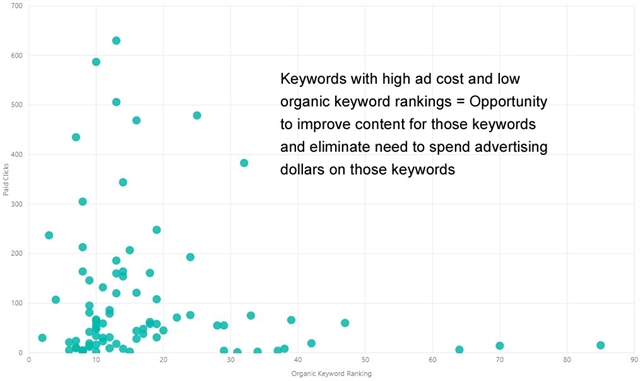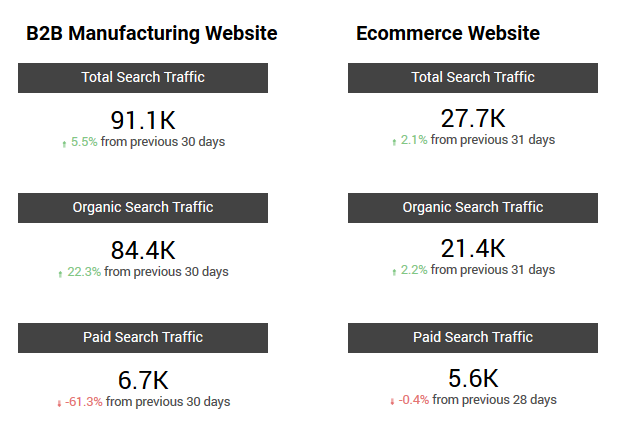We SEOs call ourselves “technical SEOs,” “local SEOs” and “content SEOs.” We never call ourselves “paid SEOs.”
Maybe we’d be better off calling ourselves – or at least thinking of ourselves – as “all of the above.”
The core definition of Search Engine Optimization does not end with driving organic traffic. This is especially true in 2020, when paid ads can drive upwards of 65% of all clicks, depending on the search intent of the query.
We know that PPC drives an important part of traffic to websites, yet the literature and agency structures position SEO as somehow opposed to PPC. These silos and the underlying competition they foster do not produce the best results for businesses.
In 2020, let’s replace SEO vs. PPC with a unified search practice encompassing technical, local, content AND paid.
At Northwoods, we have applied this unified approach in service of our clients and have achieved some awesome results for them. In the interest of establishing this practice as an industry standard, we are sharing a few of our case studies, lessons learned and tips for getting started.
A Little Background
The idea for combining our PPC and SEO services started a couple years back, when I heard Wil Reynolds talk about using paid search term data to inform a content strategy. His approach to using Power BI to build a relationship between search terms and keyword data inspired me to challenge our team to do the same for our clients. It revolutionized the way we develop content topics.

This year, our search team used the same approach to reduce or eliminate PPC budget for branded search for two clients. This freed money for unbranded terms and content development, two strategic areas that needed greater focus and attention. By diverting money from PPC and focusing it on areas of opportunity for growth, we were able to drive more traffic and conversions for these clients.
The Approach
Measurement of effectiveness is the most important part of any strategy. We started with this question: How can we stop measuring SEO traffic and PPC traffic separately, and instead measure all search traffic together?
Total Search Traffic measurement yields deeper understanding of how our organic and paid tactics work together to make a positive impact on a business. Once you focus on Total Search Traffic, you can break it down into the various SERP features to determine the effectiveness of your tactics. Key categories of search traffic include:
- Paid Search Ads
- Paid Shopping Ads
- Knowledge Graph
- Local Pack
- Images
- Features Snippets
- PAA
- Traditional organic results
Organized measurement helps us to think critically about the approach for our search strategy. We can break it into key areas of focus all aimed at improved Total Search Traffic volume.
The Experiment to Bring PPC and SEO Together
We experimented with two clients, one B2B and one Ecommerce, to see if we could eliminate their branded paid search budget.
We hypothesized that if we eliminated the paid branded search queries (the company name keywords), that the Paid Search Ads traffic would go down and the Traditional Organic traffic would go up, with the net result of unchanged Total Search Traffic.
Our hypothesis got one thing wrong: Total Search Traffic wasn’t flat. It increased.

Had we looked at these numbers separately and presented them to our clients separately, we would have lost the PPC business. A 61% drop in paid search traffic! Yikes!
But because we approached it as a team, without competition, we were able to deliver improved total results and save these businesses money.
In both cases, each client had been spending large sums on branded search terms. Now they can invest that money in more advertising for unbranded keywords or in more content development, which would increase their organic keyword universe.
What Does this Mean for SEO in 2020?
I admit that this very small case study does not account for a number of variables that could have come into play for both businesses. But the experiment nonetheless indicates that we should stop segmenting our measurement results and start working together as a comprehensive search team comprising SEOs, PPC specialists, content teams, developers and more.
I’d like 2020 to be the year of unification. All SEO and PPC strategists should work together to deliver the best results for their clients. If that means that your paid cost/conversion goes up because you are spending money on high-competition words and letting organic handle the cheaper keywords, that’s okay!
We still need organic search strategies and featured snippet strategies. We still need local search strategies and paid search strategies. We still need great content, targeted keywords, schema.org markup and all the tactics we have implemented in the past. My hope is that 2020 is the year SEOs find a way to take great ideas on all sides of the Search world and work as teams to help businesses spend their money more wisely.
My resolution is to lead by example and approach Search Engine Optimization from all sides. That is what we will be doing at Northwoods and I hope more SEOs and PPCs join in that effort.